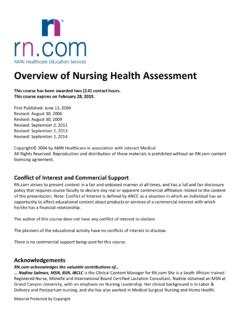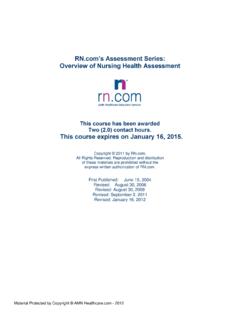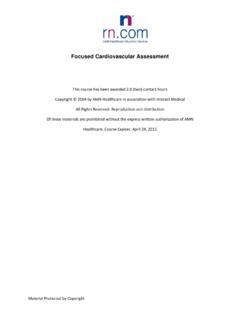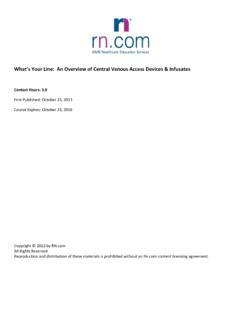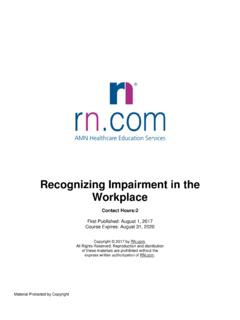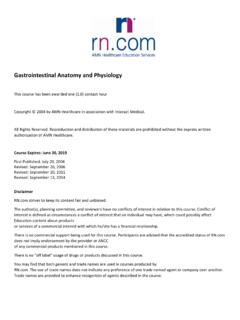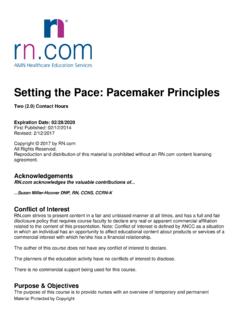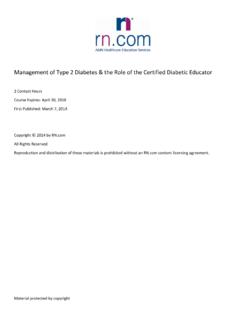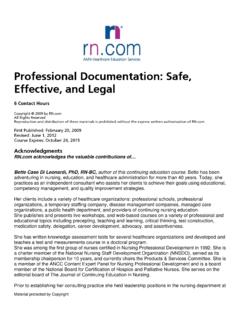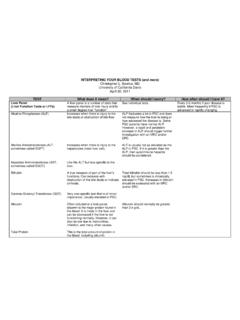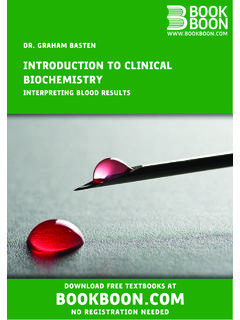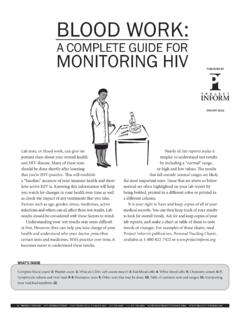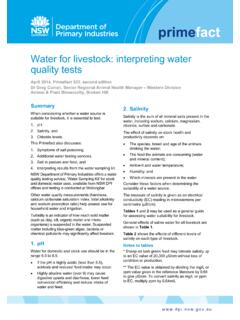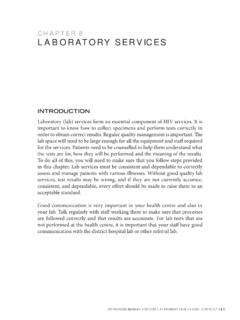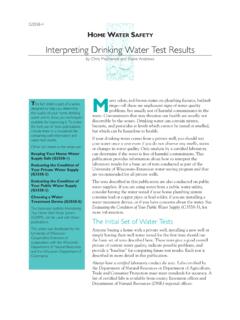Transcription of Lab Values: Interpreting Chemistry and Hematology for ...
1 Material protected by Copyright lab values : Interpreting Chemistry and Hematology for Adult Patients 2 Contact Hours Copyright 2011 by All Rights Reserved Reproduction and distribution of these materials is prohibited without the express written authorization of First Published: March 30, 2012 Course Expires: March 30, 2015 Material protected by Copyright Acknowledgments acknowledges the valuable contributions Kim Maryniak, RNC-NIC, BN, MSN has over 22 years staff nurse and charge nurse experience with med/surg, psychiatry, pediatrics, including 13 years in neonatal intensive care. She has been an educator, instructor, and nursing director. Her instructor experience includes maternal/child and med/surg nursing, physical assessment, and research utilization. Kim graduated with a nursing diploma from Foothills Hospital School of Nursing in Calgary, Alberta in 1989. She achieved her Bachelor in Nursing through Athabasca University, Alberta in 2000, and her Master of Science in Nursing through University of Phoenix in 2005.
2 Kim is certified in Neonatal Intensive Care Nursing and is currently pursuing her PhD in Nursing. She is active in the National Association of Neonatal Nurses and American Nurses Association. Kim s recent roles in professional development and management include neonatal and pediatric care, nursing peer review and advancement, teaching, and use of simulation. Disclaimer strives to keep its content fair and unbiased. The author(s), planning committee, and reviewers have no conflicts of interest in relation to this course. There is no commercial support being used for this course. Participants are advised that the accredited status of does not imply endorsement by the provider or ANCC of any commercial products mentioned in this course. There is "off label" usage of medications discussed in this course. You may find that both generic and trade names are used in courses produced by The use of trade names does not indicate any preference of one trade named agent or company over another.
3 Trade names are provided to enhance recognition of agents described in the course. Note: All dosages given are for adults unless otherwise stated. The information on medications contained in this course is not meant to be prescriptive or all-encompassing. You are encouraged to consult with physicians and pharmacists about all medication issues for your patients. Material protected by Copyright Purpose The purpose of this continuing education module is to provide nurses with the knowledge and skills to recognize changes in common Chemistry and complete blood count lab values . Additionally, after completing this module, you will be able to discuss reasons why these common lab values may be either elevated or decreased. Learning Objectives After successful completion of this course, you will be able to: Identify normal Chemistry values for the adult patient Define the normal range of laboratory values for components of a complete blood count for the adult patient Explain at least two causes and complications of abnormal Chemistry values and complete blood count Identify at least one treatment associated with abnormal findings Material protected by Copyright Introduction Using laboratory values can be a key piece of assessment to determine what is occurring within the body of a patient.
4 There are numerous laboratory tests that can be done. The most common tests include Chemistry panels, Hematology (such as the complete blood count), and blood gases. This course will take a closer look at these components. lab values for this course are taken from the Rush Medical Laboratory (Rush University Medical Center, 2012). Remember that there is some variation in ranges based on the laboratory, so be aware of the normal ranges for your facility. Introduction to Electrolytes Electrolytes The human body is constantly trying to keep a balance of homeostasis with fluid and electrolytes. Electrolytes are chemical compounds that break down into ions, carrying a positive or negative charge. When these are not in balance, pathological changes occur in the human body (LeFever, Paulanka, & Polek, 2010). Sodium (Na+) Sodium (Na+) is the major component of extracellular fluid (ECF). The normal values are 137-147 mmol/L Na+ takes part in the regulation of acid-base balance, tissue osmolality and enzyme activity.
5 Na+ is also essential for the retention of body water by maintaining osmotic pressure (LeFever, Paulanka, & Polek, 2010). Potassium (K+) Potassium (K+) is the major component of intracellular fluid (ICF). The normal value range is mmol/L. K+ participates in enzyme activity, regulation of tissue osmolality and glycogen use. K+ is also essential for cardiac function and central nervous system function by regulating muscle and nerve excitability (LeFever, Paulanka, & Polek, 2010). Chloride (Cl-) Chloride (Cl-) is another component of ECF, with normal values between 99-108 mmol/L. Cl- participates in tissue and cell osmolality, and passively follows sodium and water. Cl- is necessary for K+ retention, transport of carbon dioxide (CO2), and formation of hydrochloric acid (HCL) in the gastrointestinal tract. Cl- is usually provided in the form of NaCl or KCl (LeFever, Paulanka, & Polek, 2010). Material protected by Copyright Magnesium (Mg2+) Magnesium (Mg2+) is found in the bone (50%), the ICF (45%), and the ECF (5%).
6 The normal range is mg/dL. Mg2+ affects enzyme activity, cardiac and neuromuscular function. Deficits with Mg2+ are usually seen with deficits in Ca2+ and/or K+ (LeFever, Paulanka, & Polek, 2010). Calcium (Ca2+) Calcium (Ca2+) is another component of the ECF, but the majority is found in the bone. The normal values are mg/dL. Ca2+ is essential in blood coagulation, endocrine functions, and neuromuscular function such as muscular contraction and nerve excitability. Ca2+ serum values may vary, depending on total serum protein, as a relationship exists between the two. Abnormal total serum Ca2+ levels should be verified with an ionized Ca2+ level, as this measurement is independent of serum protein levels. Parathyroid and thyroid hormones as well as vitamin D also influence Ca2+ values (LeFever, Paulanka, & Polek, 2010). Phosphorus (P+) Phosphorus (P+) is found in the bone and the ICF. The normal range of values is mg/dL.
7 P+ plays a role in neuromuscular function, formation of bones and teeth, body metabolism of nutrients, and forming and storing of energy such as ATP. A relationship exists between P+ and Ca2+. Therefore, if one value is abnormal, the other should be evaluated as well (LeFever, Paulanka, & Polek, 2010). Material protected by Copyright Review of Electrolytes Material protected by Copyright Electrolyte Imbalances: Hypernatremia Hypernatremia and hyperchloremia are related. Causes include: Dehydration Decreased water intake Over-administration of Na+ supplementation Diuresis Any process that causes a loss of free fluid results in increased Na+ concentration (such as vomiting , diarrhea, insensible water loss through excessive perspiration) Impaired renal function Cushing s syndrome Congestive heart failure Hypernatremia: Clinical Picture Signs and symptoms of hypernatremia include.
8 Anorexia, nausea, vomiting Dry tongue and mucous membranes Tachycardia Hypertension Behavior that is restless, agitated Altered level of consciousness Febrile Hyperreflexia Tremors or muscle twitching Decreased skin turgor Concentrated urine Treatment of hypernatremia is focused on the underlying cause(s) (LeFever, Paulanka, & Polek, 2010). Material protected by Copyright Electrolyte Imbalances: Hyponatremia Causes of hyponatremia include: Prolonged use of D5W (this dilutes the ECF, causing water intoxication) Impaired renal function (such as salt-wasting renal disease) Syndrome of inappropriate antidiuretic hormone (SIADH) Addison s disease Burns Fever Metabolic alkalosis Overhydration Water retention (water retention causes a dilution of serum Na+, but the total body Na is within normal limits.)
9 This can be seen with renal failure, hepatic failure, congestive heart failure, etc.) Diuretics Low sodium intake Material protected by Copyright Hyponatremia: Clinical Picture Diarrhea, nausea, vomiting Tachycardia Hypotension Headaches, lethargy, confusion Muscle weakness Signs and symptoms of hypernatremia include: Pallor Dry skin and mucous membranes Dilute urine Treatment of hyponatremia is based on the cause(s). Na+ needs to be replaced slowly (LeFever, Paulanka, & Polek, 2010). Electrolyte Imbalances: Hyperkalemia Potassium levels can be falsely elevated with hemolyzed blood samples. Causes of hyperkalemia include: Over-administration of potassium supplements Metabolic acidosis Renal failure Potassium-sparing diuretics ACE inhibitors, beta-blockers (both affect potassium balance) Trauma/bruising/bleeding (cell breakdown causes potassium loss) Addison s disease Material protected by Copyright Hyperkalemia: Clinical Picture Clinical signs and symptoms of hyperkalemia include: ECG changes: tachycardia, widened QRS, peaked T waves, lengthening of PR interval, P wave difficult to identify, ventricular fibrillation Decreased urine output Lethargy Decreased muscle tone, muscle cramps Treatment is of the underlying cause(s).
10 If the cause is acidosis, then it must be corrected. Diuretics may be used if renal problem. In addition, the following are treatments for hyperkalemia: Kayexalate: This is a cation-exchange resin, Na+ based (An ion-exchange resin that has the ability to exchange positive ions in the stationary phase with positive ions in solution) Calcium administration: Used to decrease the antagonistic effect of potassium excess on the myocardium Insulin/glucose drip: Insulin enhances cellular uptake of K+, forcing it back into cells (LeFever, Paulanka, & Polek, 2010). Material protected by Copyright Electrolyte Imbalances: Hypokalemia Causes of hypokalemia include: Malnutrition, anorexia Decreased K+ intake Alcoholism K+ losses through vomiting, diarrhea, or gastric suctioning Diuretics Acute renal failure Steroids Stress Insulin Epinephrine, bronchodilators Metabolic alkalosis Cushing s syndrome Hypokalemia: Clinical Picture Clinical signs and symptoms of hypokalemia include: ECG changes.
